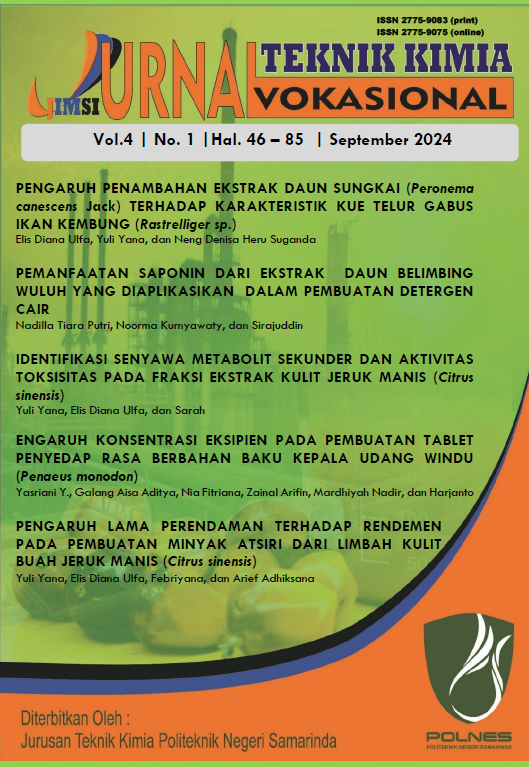PENGARUH KONSENTRASI EKSIPIEN PADA PEMBUATAN TABLET PENYEDAP RASA BERBAHAN BAKU KEPALA UDANG WINDU (Penaeus monodon)
 Abstract views: 155
,
Abstract views: 155
,
 pdf downloads: 643
pdf downloads: 643
Abstract
Shrimp heads, which are usually discarded, are a byproduct often produced during shrimp processing. The heads of Panaeus monodon contain glutamic acid, an amino acid with the ability to impart a umami taste. The heads can be made into natural flavoring tablets through a wet granulation process. The aim of this research is to determine the concentration of fillers that affect the physical properties of tablets. To fill the shrimp head powder, amilum manihot and monohydrate lactose were added at concentrations of 5%, 10%, 15%, 20%, and 25%. Gradually, a 5% PVP was added to the mixture and kneaded until smooth. The wet granules are sieved with a 12-mesh sieve, then dried for two hours in an oven at 60 degrees Celsius. The dry granules are sieved with a 16-mesh sieve, and PEG 4000 is added at 2% of the dry granule weight. A tablet press is used to process the mixture. Then a weight uniformity, brittleness, and disintegration time test were conducted. The results show that the flavoring tablets with a 5% concentration of cassava starch as the filler have a weight uniformity of 1.4%, a brittleness of 0.7%, and a disintegration time of 6 seconds. The flavoring tablets with a 25% concentration of monohydrate lactose as the filler have weight uniformity, brittleness, and disintegration time characteristics of 0.3%, 0.2%, and 18 seconds, respectively. Based on the brittleness test results, the flavoring tablets with a 25% concentration of monohydrate lactose as the filler have the best characteristics.
Keywords: excipients, shrimp heads, tablets, umami, wet granulation
Copyright (c) 2024 JURNAL TEKNIK KIMIA VOKASIONAL (JIMSI)

This work is licensed under a Creative Commons Attribution-NonCommercial-ShareAlike 4.0 International License.
Copyright Transfer Statement
The copyright of this article is transferred to JIMSI and when the article is accepted for publication. the authors transfer all and all rights into and to paper including but not limited to all copyrights in the Psikostudia. The author represents and warrants that the original is the original and that he/she is the author of this paper unless the material is clearly identified as the original source, with notification of the permission of the copyright owner if necessary. The author states that he has the authority and authority to make and carry out this task.
The author states that:
- This paper has not been published in the same form elsewhere.
- This will not be submitted elsewhere for publication prior to acceptance/rejection by this Journal.
A Copyright permission is obtained for material published elsewhere and who require permission for this reproduction. Furthermore, I / We hereby transfer the unlimited publication rights of the above paper to Jurnal Teknik Kimia Vokasional. Copyright transfer includes exclusive rights to reproduce and distribute articles, including reprints, translations, photographic reproductions, microforms, electronic forms (offline, online), or other similar reproductions.
The author's mark is appropriate for and accepts responsibility for releasing this material on behalf of any and all coauthor. This Agreement shall be signed by at least one author who has obtained the consent of the co-author (s) if applicable. After the submission of this agreement is signed by the author concerned, the amendment of the author or in the order of the author listed shall not be accepted.
Rights / Terms and Conditions Saved
- The author keeps all proprietary rights in every process, procedure, or article creation described in Work.
- The author may reproduce or permit others to reproduce the work or derivative works for the author's personal use or for the use of the company, provided that the source and the Informatika Mulawarman copyright notice are indicated, the copy is not used in any way implying the Jurnal Psikostudia approval of the product or service from any company, and the copy itself is not offered for sale.
- Although authors are permitted to reuse all or part of the Works in other works, this does not include granting third-party requests to reprint, republish, or other types of reuse.
Jurnal Teknik Kimia Vokasional by http://e-journal.polnes.ac.id/index.php/jimsi licensed under a Creative Commons Attribution-ShareAlike 4.0 International License.








